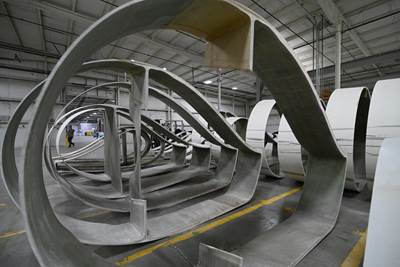Swedish parking garage to incorporate decommissioned wind blades
Architect Jonas Lloyd is working with Vattenfall to design the multistory building with a wind blade façade, targeting eco-friendly buildings and creative ways to remove blades from landfills.

Rendered parking garage design. Source | Vattenfall
In a new neighborhood located in Lund, Sweden, the façade of an eco-friendly, multistory car park is going to feature turbine blades from a decommissioned wind farm. The parking garage, commissioned by Lund’s parking company LKP, is headed up by architect Jonas Lloyd at Lloyd’s arkitektkontor, who says he became inspired by an article he had read about the problem of wind turbine blades in landfills.
“To take something that is perfectly functional, arguably one of the best materials in the world — more or less indestructible — and just bury it in the ground is such a terrible waste,” says Lloyd.
The blades he plans to incorporate come from Vattenfall’s (Solna, Sweden) decommissioned Danish wind park, Nørre Økse Sø, and will be used to create the car park’s “curtain walls” (nonstructural walls), together with green walls from pollinator-friendly plants. Lloyd also plans to cover the roof with solar panels and use batteries to store the produced electricity for cars that are typically charged at night.
Lloyd points out that the sawn turbine blades are perfect for a parking house’s façade, since the walls are supposed to be open due to explosion and fire risks. “We wanted to create what is called ‘visible sustainability.’ People will walk past and say, ‘look at that, they've used wind turbine blades in the façade,’” says Lloyd.
And since the whole blade cannot be used, discussions are ongoing with the Swedish Transport Administration to incorporate these unused parts as noise barriers next to motorways or railroads.
Sustainability is also sought after by ridding landfills of some of these turbine blades in a more environmentally friendly way, while also reducing the use of other building materials (concrete and steel) which tend to have larger climate footprints.
Environment and sustainability specialist, Gustav Frid, has been working on the project on Vattenfall’s side, with Danish wind turbine decommissioning and recycling company Kingo Wind (Silkeborg) handling the old wind turbine blades. He says that Vattenfall has already banned putting decommissioned wind turbine blades in landfills, setting a 50% recycling rate target for turbine blades by 2025 and 100% by 2030, which it is currently on track to meet.
“We need many different solutions, because there will be a huge amount of material to be handled.”
“Even if our targets are focusing on recycling, we take a circular approach, looking at different strategies in line with the waste hierarchy,” says Fride. “Even if a product has reached its end of life, from our point of view it can be valuable for someone else in a new application or as material for a new product.”
He says that the first option when decommissioning a wind farm is to see if the turbines can be used somewhere else in their entirety, and then selling the turbines. If selling is not an option, Vattenfall is working to reuse and recycle in several projects where the turbine blades are turned into frames for solar panels, or flakes used for “extruded building products” such as beams, into isolation material, building panels or even skis.
The fallback option for the company when no other alternatives are available — some markets are more mature when it comes to recycling and reuse than others — is cement coprocessing. This process involves incinerating materials like plastics and wood to recover energy, leaving the glass fiber to be recycled and used as a substitute for sand in cement production. Carbon fiber, which is a more common material in newer blades and also more valuable, is generally recycled in a separate process.
For the industry to become truly circular, political decisions are needed however, says Frid. “There are no real incentives to use these products. By being active in research projects and pilot projects we can test, learn and show what is possible. In this way, we help pushing the legislation towards more reuse.”
Manufacturing blades that are designed to be easier to recycle can also help companies take steps in this direction. One example is Vattenfall’s new Netherlands-based Hollandse Kust Zuid offshore wind farm where a new type of recyclable blades were used, although only for some of the turbines due to limited availability. Methods to disassemble and recycle older blades are also still being developed and commercialized at a large scale.
“We need many different solutions, because there will be a huge amount of material to be handled,” says Frid. “In the long term, it may turn out that there is a most optimal way to recycle in all respects. But initially we will require many different technologies.”
Related Content
Paris Air Show 2023 highlights
The Paris Air Show, one of the largest aerospace trade shows in the world, returned for the first time since 2019 and proved that the global aviation industry industry is very much alive and kicking.
Read MoreSinonus launches energy-storing carbon fiber
Swedish deep-tech startup Sinonus is launching an energy-storing composite material to produce efficient structural batteries, IoT devices, drones, computers, larger vehicles and airplanes.
Read MoreTU Munich develops cuboidal conformable tanks using carbon fiber composites for increased hydrogen storage
Flat tank enabling standard platform for BEV and FCEV uses thermoplastic and thermoset composites, overwrapped skeleton design in pursuit of 25% more H2 storage.
Read MorePartners recycle A350 composite production waste into adjustable-length rods for MFFD
Herone, Spiral RTC, Teijin Carbon Europe and Collins Aerospace Almere recycle A350 thermoplastic composite clips/cleats waste into rods for the all-thermoplastic composite Multifunctional Fuselage Demonstrator’s crown.
Read MoreRead Next
ECORES WIND builds on wind blade circularity initiatives
Latest Horizon Europe project seeks to introduce innovative circular resins combined with advanced disassembly strategies, enabling cost-effective blade decommissioning and material reuse.
Read MoreRepurposing wind blades as functional community art pieces
Ohio-based Canvus Inc. upcycles fiberglass wind blades, car tires and post-consumer plastics to create outdoor furniture that amplifies sustainability messages in community spaces.
Read MoreAll-recycled, needle-punched nonwoven CFRP slashes carbon footprint of Formula 2 seat
Dallara and Tenowo collaborate to produce a race-ready Formula 2 seat using recycled carbon fiber, reducing CO2 emissions by 97.5% compared to virgin materials.
Read More
























